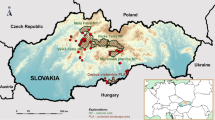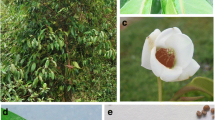Abstract
Moose (Alces alces cameloides) is typically representative of the fauna of the frigid temperate zone and has been put on the Chinese second priority list of protected animals. The moose of northeast China is on the southern most edge of its distribution in Asia. To study resource selection characteristics of moose and their response to human disturbances and forest resource variables, the field work was conducted in Heilongjiang Provincial Shengshan Forestry Farm, which is located in the northwestern slope of Lesser Khingan Mountains, northeastern China, from January to March in both 2006 and 2007. A total of 428 plots were examined within the study area. Signs of moose use were found in 19 plots. Based on the analysis of resource selection function, we found that moose selected areas with higher densities of mixed deciduous broadleaf patch and mixed coniferous and broad leaf patch, and a higher NDVI value. Moose avoided settlement 6 km away and remained low probability of occurrence within 3 km from roads, whereas higher within 4 km from trails. Our results suggested that the behavior of avoidance for human disturbance (i.e. settlement and roads) may indirectly pose habitat loss. Therefore, resource selection function models and corresponding graphs of important habitat disturbances can be used to guide and evaluate future development plans.
Similar content being viewed by others
References
Anderson DR, Burnham KP, Thompson WL. 2000. Null hypothesis testing: problems, prevalence, and an alternative. Journal of Wildlife Management, 64: 912–923.
Bailey DW, Gross JE, Laca EA, Rittenhouse LRR, Coughenour MB, Swift DM, Sims PL. 1996. Mechanisms that result in large herbivore grazing distribution patterns. Journal of Range Management, 49: 386–400.
Chang H, Xiao QZ. 1988. The selection of red deer habitat in Dailing region during the winter. Acta Theriologica Sinica, 8: 81–88. (in Chinese with English summary)
Cihlar J, Laurent LST, Dyer JA. 1991. Relation between the normalized difference vegetation index and ecological variables. Remote Sensing of the Environment, 35: 279–298.
Cohen JA. 1960. A coefficient of agreement for nominal scales. Educational and Psychological Measurement, 20: 37–46.
Crist EP, Ciscone RC. 1984. Application of the tasseled cap concept to simulated thematic mapper data. Photogrammetric Engineering and Remote Sensing, 50: 343–352.
Csillag F, Fortin MJ, Dungan JL, 2000. On the limits and extensions of definition of scale. Bulletin of the Ecological Society of America, 81: 230–232.
Czech B. 1991. Elk behavior in response to human disturbance at Mt. St. Helens National Volcanic Monument. Applied Animal Behaviour Science, 29: 269–277.
Dale MRT. 2000. Lacunarity analysis of spatial pattern: a comparison. Landscape Ecology, 15: 467–478.
Dempster JP, Pollard E. 1986. Spatial heterogeneity, stochasticity, and the detection of density dependence in animal populations. Oikos, 46: 413–416.
Dixon BG. 1997. Cumulative effects modeling for grizzly bears in the greater Yellowstone Ecosystem. MSc Thesis, Montana State University, Bozeman, Montana, USA: 15–35.
Dugan J, Perry JN, Dale MRT, Legendre P, Citron-Pousty S, Fortin MJ, Jakomulska A, Miriti M, Rosenberg MS. 2002. A balanced view of scale in spatial statistical analysis. Ecography, 25: 626–640.
Dunning JB, Danielson BJ, Pulliam HR. 1992. Ecological processes that affect populations in complex landscapes. Oikos, 65: 169–175.
Dussault C, Ouellet JP, Courtois R, Huot J, Breton L, Jolicoeur H. 2005. Linking moose habitat selection to limiting factors. Ecography, 28: 619–628.
ERDAS Inc. 2001. ERDAS IMAGINE 8.5 Tour Guides.
ESRI (Environmental System Research Institute). 1996. Using ArcView GIS. ESRI, Inc., Redlands, Califonia, USA.
Fielding AH, Bell JF. 1997. A review of methods for the assessment of prediction errors in conservation presence/absence models. Environmental Conservation, 24: 38–49.
Fortin D, Fryxell J M, O’Brodovich L, Frandsen D. 2003. Foraging ecology of bison at the landscape and plant community levels: The applicability of energy maximization principles. Oecologia, 134: 219–227.
Frid A. 2003. Dall’s sheep responses to overflights by helicopter and fixed-wing aircraft. Biological Conservation, 110: 387–399.
Hosmer DW, Lemeshow S. 2000. Applied logistic regression. John Wiley and Sons, New York, USA.
Ihaka R, Gentleman R. 1996. R: A language for data analysis and graphics. Journal of Computational and Graphical Statistics, 5: 299–314.
Jaeger JAG, Bowman J, Brennan J, Fahrig L, Bert D, Bouchard J, Charbonneau N, Frank K, Ruber B, Tluk von Toschanowitz K. 2005. Predicting when animal populations are at risk from roads: an interactive model of road avoidance behavior. Ecological Modelling, 185: 329–348.
Jaeger JAG, Fahrig L. 2004. Effects of road fencing on population persistence. Conservation Biology, 18: 1651–1657.
Jiang GS, Ma JZ, Zhang MH, Stott P. 2009. Multiple spatial scale resource selection function models in relation to human disturbance for moose in northeastern China. Ecological Research, 24: 423–440.
Jiang GS, Ma JZ, Zhang MH, Stott P. 2010. Multi-scale foraging habitat use and interactions by sympatric cervids in northeastern China. Journal of Wildlife Management, 74: 678–689.
Jiang GS, Ma JZ, Zhang MH. 2006. Spatial distribution of ungulate responses to habitat factors in Wandashan Forest Region, northeastern China. Journal of Wildlife Management, 70: 1470–1476.
Jiang GS, Ma JZ, Zhang MH. 2007. Effects of human disturbance on movement, foraging and bed selection in red deer Cervus elaphus xanthopygus from the Wandashan Mountains, northeastern China. Acta Theriologica, 52: 435–446.
Johnson CJ, Boyce MS, Case RL, Cluff HD, Gau RJ, Gunn A, Mulders R. 2005. Cumulative effects of human developments on Arctic wildlife. Wildlife Monographs, 160: 1–36.
Johnson CJ, Boyce MS, Mulders R, Gunn A, Cluff HD, Case RL. 2004. Quantifying patch distribution at multiple spatial scales: application to wildlife-habitat models. Landscape Ecology, 19: 869–882.
Keating KA, Cherry S. 2004. Use and interpretation of logistic regression in habitat selection studies. Journal of Wildlife Management, 68: 774–789.
Lennart H. 2002. Mammal movements and foraging at remnant woodland inside coniferous forest landscape. Forest Ecology and Management, 160: 109–114.
Li YZ, Xiao QZ, Chen HP. 1992. Interspecies relation among moose, red deer and roe deer during winter in Shengshan Forest Farm, Heilongjiang Province. Acta Theriologica Sinica, 2: 110–116. (in Chinese with English summary)
Loyn RH, McNabb EG, Volodina L, Willig R. 2001. Modelling landscape distributions of large forest owls as applied to managing forests in north-east Victoria, Australia. Biological Conservation, 97: 361–376.
Ma YQ. 1989. Wildlife in Greater Khingan Mountains. Harbin, China: Northeast Forestry University Press, 79–93. (In Chinese)
Mace RD, Waller JS, Manley TL, Lyon LJ, Zuuring H. 1996. Relationships among grizzly bears, roads and habitat in the Swan Mountains, Montana. Journal of Applied Ecology, 33: 1395–1404.
Mahoney SP, Schaefer JA. 2002. Hydroelectric development and the disruption of migration in caribou. Biological Conservation, 107: 147–153.
Maichak EJ. 2004. Applicability of viewshed analysis to wildlife population estimation. The American Midland Naturalist, 152: 277–285.
Maier JAK, Ver Hoef JM, McGuire AD, Bowyer RT, Saperstein L, Maier HA. 2005. Distribution and density of moose in relation to landscape characteristics: effects of scale1. Canadian Journal of Forest Research, 35: 2233–2243.
Manly BFJ, McDonald LL, Thomas DL, McDonald TL, Erickson WP (eds). 2002. Resource selection by animals. Second edition. Dordrecht: Kluwer Academic Publishers, pp.1–221.
Menard S. 2001. Applied logistic regression analysis. Sage University Paper series on Quantitative Applications in the Social Sciences, series no.07-106. Thousand Oaks, California, USA.
Millspaugh JJ, Raedeke KJ, Brundige GC, Willmott CC. 1998. Summer bed sites of Elk (Cervus elaphus) in the Black Hills, South Dakota: considerations for thermal cover management. The American Midland Naturalist, 139: 133–140.
Nellemann C, Cameron RD. 1998. Cumulative impacts of an evolving oil-field complex on the distribution of calving caribou. Canadian Journal of Zoology, 76: 1425–1430.
Nielsen SE, Cranston J and Stenhouse GB. 2009. Identification of priority areas for grizzly bear conservation and recovery in Alberta, Canada. Journal of Conservation Planning, 5: 38–60.
Norusis MJ. 1999. SPSS for Windows Regression Models. 9.0. Englewood Cliffs: Prentice Hall, p.135.
Ormsby T, Alvi J. 1999. Extension ArcView GIS. Redlands, Calif., USA: ESRI Press.
Pearce J, Ferrier S. 2000. Evaluating the predictive performance of habitat models developed using logistic regression. Ecological Modelling, 133: 225–245.
Peng CJ, Lee KL, Ingersoll GM. 2002. An introductionto logistic regression analysis and reporting. The Journal of Educational Research, 96: 3–14.
Piao RZ, Guang GS, Zhang MH. 1995. Population size and distribution of moose in China. Acta Theriologica Sinica, 15: 11–16. (in Chinese with English summary)
R Development Core Team. 2006. R: A language and environment for statistical computing. R Foundation for Statistical Computing, Vienna, Austria. ISBN 3-900051-07-0, URL http://www.R-project.org.
Schoen JW, Flynn RW, Suring LH, Trrus K, Beier LR. 1994. Habitat-capability model for brown bear in Southeast Alaska. Bears: Their Biology and Management, 9: 327–337. (In: proceedings of symposia of the International Conference for Bear Research and Management),.
Stenseth NC. 1980. Spatial heterogeneity and population stability: some evolutionary consequences. Oikos, 35: 165–184.
Stevens MA, Boness DJ. 2003. Influences of habitat features and human disturbance on use of breeding sites by a declining population of southern fur seals (Arctocephalus australis). Journal of Zoology, 260: 145–152.
Suring LH, Barber KR, Schwartz CC, Bailey TN, Shuster WC, Tetreau MD. 1998. Analysis of cumulative effects on brown bears on Kenai Peninsula, southcentral Alaska. Ursus, 10: 107–117.
Turner MG, Dale VH, Gardner RH. 1989. Predicting across scales: theory development and testing. Landscape Ecology, 3: 245–252.
Vistnes I, Nellemann C. 2001. Avoidance of cabins, roads, and power lines by reindeer during calving. Journal of Wildlife Management, 65: 915–925.
Wang J, Robinson GJ, Wiitie K. 1996. A fast solution to local viewshed computation using grid based digital elevation models. Photogrammetric Engineering and Remote Sensing, 62: 1157–1164.
Wang S. 1998. China red data book of endangered animals: Mammalia. Beijing, Hongkong, New York: Science Press, pp.246–249. (in both Chinese and English)
Wilson BA, Aberton JG, Reichl T. 2001. Effects of fragmented habitat and fire on the distribution and ecology of the swamp antechinus (Antechinus minimus maritimus) in the eastern Otways?. Victoria Wildlife Research, 28: 527–536.
Wisdom MJ, Cook JG. 2000. North American elk. In: S. Demarais, and P.R. Krausman (eds), Ecology and management of large mammals in North America. Prentice-Hall Incorpotated, Upper Saddle River, pp.694-735
Yu XC, Xiao QZ, Lu YM. 1993. Selection and utilization ratio of winter diet, and seasonal changes in feeding and bedding habitat selection by moose in northeastern China. In: N. Ohtaishi and H.L. Sheng (eds), Deer of China: biology and management. Amsterdam: Elsevier Science Publishers, pp.172–180.
Yu XC, Xiao QZ. 1991. The food composition and seasonal change of the moose in Heihe Forest Area. Acta Theriologica Sinica, 11: 258–265. (In Chinese with English summary)
Zhang MH, Xiao QZ. 1990. A study on feeding and bedding habitat selection by red deer in winter. Acta Theriologica Sinica, 10: 175–183. (in Chinese with English summary)
Zhang MH. 2001. Wintering habitat selection by moose cold temperate zone, The Great Khingan Mountains. Acta Theriologica Sinica, 21: 310–313. (In Chinese)
Author information
Authors and Affiliations
Corresponding author
Additional information
Fund project: This work was financially supported by National Excellent Doctoral Dissertation of PR China-FANEDD (No. 201069)”, “Program for New Century Excellent Talents in University -NCET (No. 10-0310)” and “the Fundamental Research Funds for the Central Universities (No.DL12DA01).
Rights and permissions
About this article
Cite this article
Hu, Sx., Jiang, Gs., Ma, Jz. et al. Resource selection of moose (Alces alces cameloides) and their response to human disturbances in the northwestern slope of Lesser Khingan Mountains, northeastern China. Journal of Forestry Research 24, 727–734 (2013). https://doi.org/10.1007/s11676-013-0411-4
Received:
Accepted:
Published:
Issue Date:
DOI: https://doi.org/10.1007/s11676-013-0411-4




